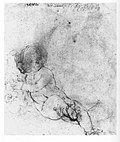Related drawings by Leonardo
- Virgin and Child with cat, recto, Uffizi
- Virgin and Child with cat, verso, Uffizi
- Virgin and Child with cat, Musée Bonnat
- Christ Child with cat, recto, British Museum
- Christ Child with cat, verso, British Museum
- Christ Child with cat, recto, British Museum
- Christ Child with cat, verso, British Museum
- Virgin and Child with cat, private collection, NYC









